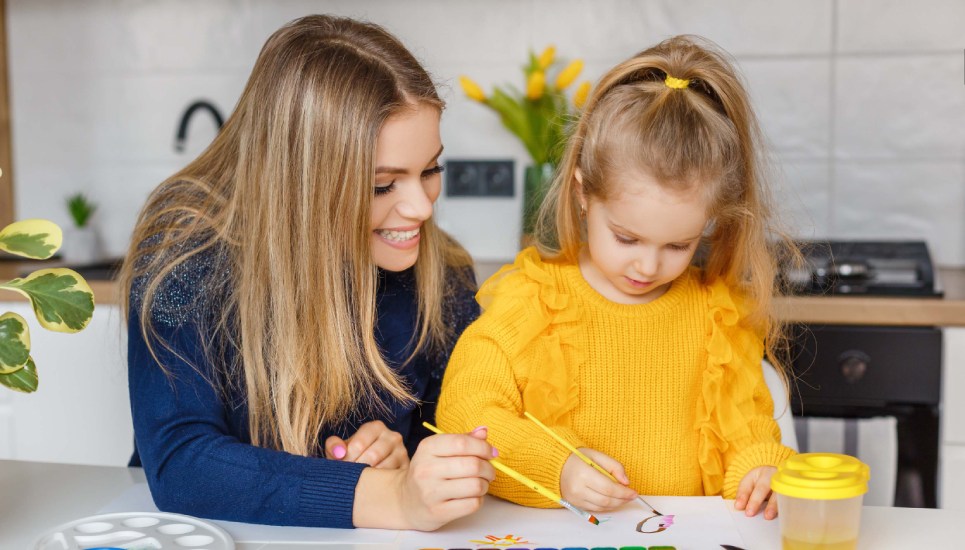
Develop Creativity in Your Child
Innovation is not an inherited talent – it can be nurtured! Creativity is characterised as the capacity to make new things. Contrary to widespread beliefs, creativity lives in every brain and thrives with training.
Inventiveness builds critical thinking and adaptability in children. These aptitudes empower kids to approach difficulties from new points of view. Corporations connect creativity with creating helpful ideas and solutions. Basically, progress and technology depend on minds that can revolutionise.
As parents and nannies, we shape children’s creative potential.
Here are approaches to cultivate innovation:
Hear Them Out
Kids naturally wonder and explore. Bolster their curiosity by:
Probing deeper with questions and suggestions – When a child shares an idea, respond with interest and engage further by asking questions. What sparked the idea? How might it work? What materials would be needed? Make suggestions to spur additional possibilities.
Helping them discover resources to expand concepts – If a child is interested in a particular topic, help them learn more! Search the internet together for videos, websites, or facts. Make a trip to the library to find books. Getting exposure to more resources on a passion feeds creativity.
Enrolling them in classes matching their interests – Supporting a child’s existing fascinations with dedicated learning opportunities can nourish creativity even further. Find local or online classes where they can develop skills and ideas with like-minded peers.
Promoting trial-and-error thinking – When kids are experimenting with an idea, encourage iterative attempts over perfection. Fostering a growth mindset where mistakes provide learning rather than failure makes innovation less intimidating.
Admiring their show-and-tell presentations – Children glean confidence and validation from positive reactions to their work. Provide specific, enthusiastic feedback when they display or demonstrate their creations.
Maintain Structure with Flexibility
Kids prosper with structure and spontaneity.
Set aside free play and inventing times – Schedule unstructured blocks where kids control activities. Without overt direction, they follow intrinsic motivations and often invent games or projects.
Designate a space for self-expression with art supplies – Define a spot where creativity can always unfold, stocked with materials to fuel inspiration. An easel, journals, building toys, craft components – the possibilities are endless!
Organise unique activities like indoor picnics – Unexpected adventures make routine exciting while sparking ideas. An indoor picnic throws a curveball which may lead to an impromptu show, concert, or imaginary feast!
Let fully engaged kids continue past schedules – If a child is captivated by an activity, permit it to organically conclude even if the calendar says move on. Passionate focus breeds innovation.
Make Them Aware of Creative Steps
Mapping the creative process makes it repeatable. Guide kids to draw or note their steps. If a block tower falls, have them rebuild while tracking used blocks. Ask questions to strengthen structures. Understanding personal methodology promotes ongoing creativity.
Think Outside The Box
Innovation training applies everywhere!
If a child despises taking out trash, ask them to come up with ideas on how to make a boring job fun to do.
Gamify tedious tasks. See who cleans fastest – Turn drones into challenges. Make mopping the floor a speed competition. Adding play makes duties vehicles for imagination.
Harness Boredom
Contrary to popular belief, boredom sparks creativity!
Keep a boredom buster idea list – Compile engaging suggestions kids can independently pursue when restlessness strikes. Crafts, reading, building projects – arm them with boredom defeating options.
Involve kids in your activities, like new cooking methods –Cooking dinner? Invite participation. Instead of passive observation, give a job. Can they invent a new way to make mashed potatoes? Hands-on engagement beats boredom while spurring ingenuity!
New Experiences Invigorate
Trying novel things fires the creative spark within children.
Mundane adult tasks can actually help develop the creativity within a child. Teach a child how to do laundry can help in development by creating games out of the tasks. With laundry, create a game by sorting colours together or who can fold the most towels the quickest. Unexpected challenges prompt random solutions.
Another great experience for a child is organised sports. Physical activities utilise different neural pathways unleashing fresh ideas and problem solving techniques. Sign your child up to a new sport and see them have fun!
Receive monthly science, art or DIY crates tailored to child interests and skill levels. Guided activities build confidence taking on unfamiliar terrain.
Creativity opens doors to improving life. Prioritising innovation empowers kids’ future contributions. Let’s cultivate the next generation of ingenious minds! Our duty is preparing kids to meet unknowns with imagination, critical thinking and vision beyond pre-existing paradigms.
Enrol in Their Journey
Creative journeys start with curiosity. Our primary responsibility as parents and nannies is listening and to plant the seeds to help a child develop. Where attention goes, energy flows.
What if your child loves taking things apart to see how they work? Instead of shutting down their curiosity, give them old appliances or gadgets to safely tinker with. Show them how things work! Validate their interests – provide tools, books, and maybe even find a mentor.
Creativity Needs Space to Roam
Invention requires room for unexpected twists, turns and surprises. But kids also thrive on routine – so we have to balance structure with flexibility.
Plan dependable schedules, while leaving space for spontaneous play or following where their attention goes. Build in “Explorer Time” where they choose activities and lead the way. Every last Friday of the month can be “Kid’s Pick Day” for adventures in the park, projects, anything that sounds fun!
And if they get totally absorbed in an activity, let it play out past the allotted time block. If LEGO building has them hooked, put off chores and let that imagination juice flow! Laser focus is prime inventing territory.
In other words, leave room for creative bug bites. Staying nimble allows inspiration to strike at unexpected moments.
FAQS
How to help a child express their creativity?
Teach Them Multiple Ways to Solve Every Problem, trigger Their Curiosity and help them to think outside of the box
Can creativity be taught to children?
As a soft skill, cretivity can be taught to a child. Learning any skill will help develop a childs creativity.
How to train creativity?
The best way is to let a childs mind wondering and then get them to express their thoughts. To keep them focused on their thoughts it is best to keep distractions away from them to get the true benifits.




